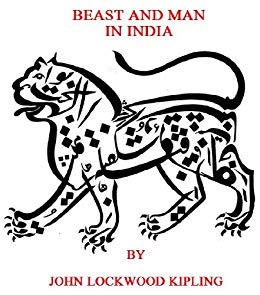On Verminous Life
by Parama Roy
 Using John Lockwood Kipling’s Beast and Man in India (1891) as her text, Parama Roy examines the encounter of two contrasting economies of animal protection and animal cruelty, especially Kipling’s understanding of carnivory as the basis not only for human sociability but also of kindness to the nonhuman.
Using John Lockwood Kipling’s Beast and Man in India (1891) as her text, Parama Roy examines the encounter of two contrasting economies of animal protection and animal cruelty, especially Kipling’s understanding of carnivory as the basis not only for human sociability but also of kindness to the nonhuman.
The essay begins:
In thinking about the history of animal protection in the nineteenth century, there is a familiar narrative that we rehearse. Prompted by a century’s worth of thinking, writing, newspaper campaigns, and abortive legislative attempts to address the question of the feelings or capacities of nonhuman animals and their claims to moral consideration from humans, the British Parliament passed an act in 1822 “to prevent the cruel and improper treatment of cattle.” Known widely as Martin’s Act, in honor of its sponsor Richard Martin of Galway, it was the first in a series of legislative undertakings—the Cruelty to Animals Act of 1835, which was repealed and replaced in 1849, 1850, 1854, and 1876, and the Wild Animals in Captivity Act of 1900—designed to curb certain forms of animal cruelty and to provide legislative recognition of the entitlement of (some) animals to human protection. Together these acts were responsible for limiting or abolishing organized animal combat, animal baiting, the beating or torture of draft animals and livestock, and live pigeon shooting, though campaigns against animal vivisection had limited success. The enforcement of these acts and the concomitant education of the public in principles of animal protection were aided by the formation in 1824 of the Society for the Protection of Animals (SPCA), a body that would gain royal sponsorship a decade and a half later. Not only was Britain the venue for what has been called “the world’s first organized animal welfare movement,” part of a wave of social reform inspired by Evangelicals, Methodists, and Quakers in the Anglophone world. By the century’s end it also boasted “the most comprehensive animal protection laws in Europe.”
Fascinating as such accounts are, they would be enriched by consideration of the fact that debates on ending animal cruelty occurred in multiply scaled transimperial, national, and regional contexts. The colony was to become a crucial theater in the nineteenth century for thinking about the ways in which models of just and civilized sociability encompassed forms of obligation to the nonhuman. More significantly, debates about what constituted animal cruelty or animal protection occurred across a religiously heterogeneous and multilingual pluriverse, including in places with well-established and consequential traditions of theory and practice about moral engagement with nonhuman life. A consideration of these transimperial, cross-continental, and extrametropolitan archives opens up the possibility of reconstellating extant narratives of cruelty and care in the nineteenth century.
Such a claim is something more than a plea, by now familiar, to grasp the interlocutions and commonalities or contiguities across metropolitan and colonial histories. It is also a meditation on the possibilities and hazards of engaging evidence across significantly disparate civilizational contexts. Reading for signs of cruelty, sympathy, and protection under such circumstances involves forms of both learning and unlearning that are instructive for an understanding of what was indubitably a multipolar modern economy of humaneness and obligation.
As an example of a text that instantiates some of these issues in a particularly emblematic way, I present John Lockwood Kipling’s Beast and Man in India (1891), without question the best-known nineteenth-century Anglophone publication on the status of animals in India. But first, a few words about its author. Kipling was a polymath whose thirty-year career as a museum director, curator of international exhibitions, art-school educator, illustrator, preservationist, journalist, and editor, first at the Sir Jamsetjee Jeejeebhoy School of Art and Industry in Bombay and then at the Mayo School of Industrial Arts at Lahore and the Lahore Central Museum, had a momentous influence on the revival of traditional arts and art education in the subcontinent. Loss of princely patronage, combined with an onslaught of mass-produced British goods, had led to a decline of craft skills in many places; Kipling took significant pains to revive these, drawing in the process upon a colonial sociology of caste to recruit students from artisan caste families to work at these institutions. He himself did not enjoy elevated status in an obsessively hierarchical imperial administration in India—he was artisanally trained and of lower middle-class origin—and yet his wife Alice and he were acquainted with several viceroys, most notably with Lord Dufferin. He achieved a significant measure of Indian, transimperial, and international fame, curating more than two dozen exhibitions in Paris, Jeypore (Jaipur), Calcutta, Glasgow, Melbourne, and elsewhere. He was a key figure in the staging of the Imperial Assemblage of 1877 that celebrated the official proclamation of Victoria as Empress of India. He had a hand, moreover, in the execution of two prestigious royal commissions—the Durbar Room at Victoria’s Osborne House and an Indian-style billiard room for Victoria’s son, the Duke of Connaught, at Bagshot Park in Surrey. He was well known in art and curatorial circles for these achievements, as well as for his many articles and illustrations, including those produced in his capacity as founder and editor of the Journal of Indian Art (later the Journal of Indian Art and Industry). Whatever he wrote on Indian arts, or Indian culture more generally, was likely to receive wide and respectful consideration.
For his Anglo-Indian compatriots, it was of equal consequence that he was a journalist of long standing, writing for the most influential newspapers of Anglo-India, the Pioneer (Allahabad) and the Civil and Military Gazette (Lahore)—as would his famous son Rudyard. In these outlets he wrote not with the expansive (if Orientalist) sympathy he brought to art education and conservation but in the legible and comparatively unoriginal idiom of Anglo-Indian conservatism; his articles thus underlined the shortcomings of the Indian educated middle class, Hindu reformers, and Indian political aspirations and mocked the follies of Bengali “baboos” and Indian servants. Several of his vignettes and written sketches for the Pioneer were repurposed for publication in Beast and Man. The book echoes sentiments widely shared by Anglo-Indians and, indeed, many Britons in the nineteenth century, though expressed much more wittily and often enlivened by the naturalist’s keen observation; many familiar tropes of Anglo-Indian writing on animals, religion, and ethics in the subcontinent reappear in it. It circulated quite extensively and, with very few exceptions, received strongly positive reviews on both sides of the Atlantic and in Anglo-India.6 It quickly came to be regarded as the single most important Anglophone text on animals and animal cruelty in India in the late Victorian period (and beyond).
Part of the remit of Beast and Man is to furnish a catalog of the varieties of domesticated and semidomesticated animal life in colonial India. But it is also a key document in thinking about animal protection and animal cruelty in the civilizational space of the colony. In this essay I will consider not the text in its entirety but its introduction, where these questions of protection and cruelty are taken up pedagogically through a proliferating set of parabolic maneuvers. Kipling’s overt objective is to furnish evidence by way of facts about the widespread practice of cruelty against animals in the subcontinent and to urge, by contrast, the superiority of a pragmatic modern economy of minimizing pain—an economy that demonstrates kindness to nonhuman life while simultaneously establishing carnivory as the basis of human concord and interdependence. But on the terrain of the Indian colony, Kipling’s economy of care and inclusion was to encounter a long-standing Indic economy, seen as non- or premodern, of vegetarianism and nonkilling of animals. This order he seeks to cast, not as kindness to animals, but as a form of cruelty to them. The encounter of these two contrasting economies of animal protection and animal cruelty in Kipling’s work yields some curious lessons about the unstable—rather than invariably triumphalist—idioms of animal protection and care in conversations that occur within and across a transimperial consortium. But before we can engage with the lessons of Kipling, it is necessary to scrutinize the two economies that meet agonistically in his text—the first being something that I name a Bania economy of conserving or saving life and the second, a modern economy of reducing suffering and administering care. Continue reading …
 PARAMA ROY is Professor of English at the University of California, Davis. She is the author of Indian Traffic: Identities in Question in Colonial and Postcolonial India (UC Press, 1998) and Alimentary Tracts: Appetites, Aversions, and the Postcolonial (Duke UP, 2010), and co-editor of States of Trauma: Gender and Violence in South Asia (Zubaan, 2009). Her current book project is titled “Empire and the Nonhuman.”
PARAMA ROY is Professor of English at the University of California, Davis. She is the author of Indian Traffic: Identities in Question in Colonial and Postcolonial India (UC Press, 1998) and Alimentary Tracts: Appetites, Aversions, and the Postcolonial (Duke UP, 2010), and co-editor of States of Trauma: Gender and Violence in South Asia (Zubaan, 2009). Her current book project is titled “Empire and the Nonhuman.”

